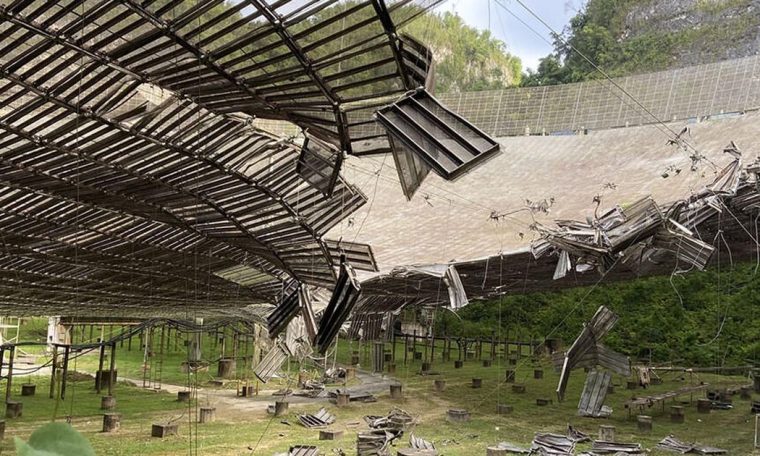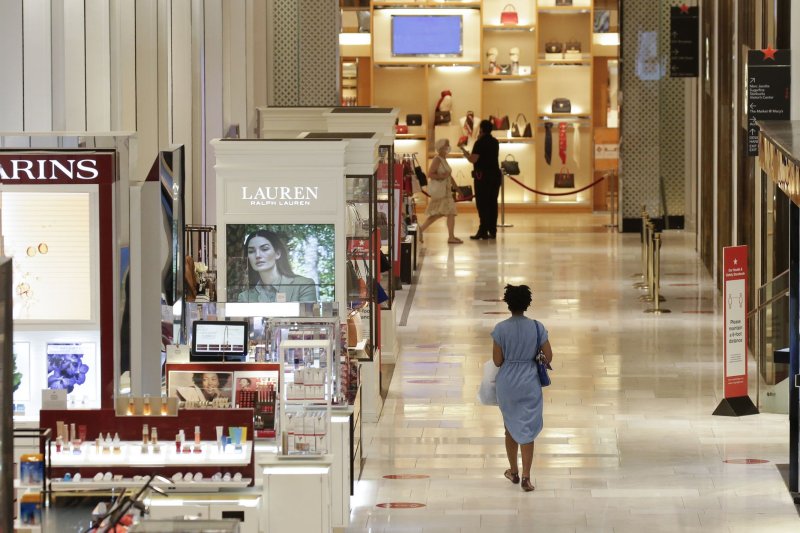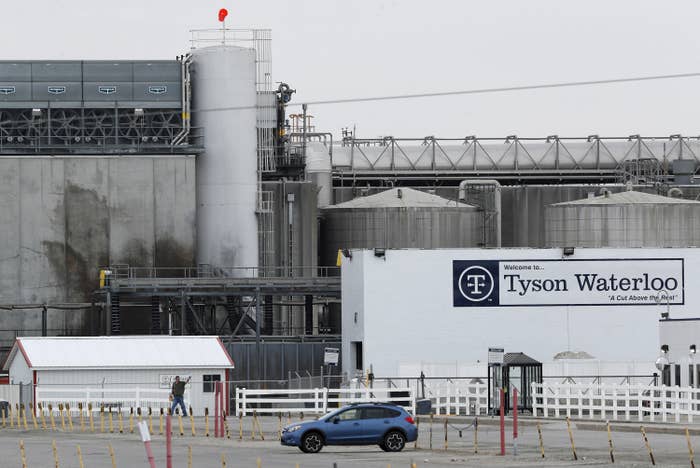UPDATE
World's most powerful radar telescope at Arecibo will be scrappedAmong the vital science conducted at the facility is the tracking of near-Earth objects -- comets or asteroids that could collide with Earth and destroy large regions.

Photo courtesy of University of Central Florida
ORLANDO, Fla., Nov. 19 (UPI) -- The iconic 18-acre radar telescope at Arecibo Observatory in Puerto Rico cannot be salvaged after it was damaged by broken cables and will be demolished, the National Science Foundation announced Thursday.
The damage from cable breaks in August and early November has left the radar dish and surrounding structures unsafe and subject to further collapse at any time, foundation officials said.
"We're actually taking measures to preserve their people and assets to ensure the facility does move forward in some fashion," said Ashley Zauderer, program director in the Division of Astronomical Sciences at the foundation.
Ancillary facilities at Arecibo that also conduct astronomical observations may be salvaged, but the central structure, the large radar telescope, will either fail on its own or be demolished as safely as possible, Zauderer said.
RELATED Arecibo Observatory incurs more damage as another support cable snaps
"The decision comes after [the foundation] evaluated multiple assessments by independent engineering companies that found the telescope structure is in danger of a catastrophic failure and its cables may no longer be capable of carrying the loads they were designed to support," a statement from the foundation said.
The telescope has been the scene of ground-breaking science and astronomy discoveries for 57 years. Two scientists using data from the dish have won Nobel Prizes. It was also the scene of popular movies like 1995's GoldenEye and Species, and 1997's Contact.
The University of Central Florida, which manages the facility, had recently submitted a request to the foundation for $10.5 million to begin repairs on the August damage. That work would include at least six massive cables, which range in thickness from 3 inches to 6 inches.
RELATED Arecibo Observatory seeks $10.5M for cable repairs after accident
But that work hadn't begun when a second larger cable broke.
"Our team has worked tirelessly...looking for ways to stabilize the telescope with minimal risk," UCF President Alexander Cartwright said Thursday in a statement.
"While this outcome is not what we had been working toward, and we are disheartened to see such an important scientific resource decommissioned, safety is our top priority," Cartwright said.
RELATED Iconic space observatory in Puerto Rico recovers after Hurricane Maria
The cables support a six-story structure and platform suspended above the dish, which houses the world's most powerful radio telescope transmitter and other instruments. When functioning properly, the observatory can beam radio waves at asteroids and other space objects, obtaining images and data as the waves bounce back to Earth.
Among the vital science conducted at the facility is the tracking of near-Earth objects -- comets or asteroids that could collide with Earth and destroy large regions.
The telescope "has allowed NASA to fully characterize the precise orbits, sizes and shapes" of such objects after they are discovered by a different technology, known as a wide-field optical telescope survey, the agency said Thursday in a statement.
"NASA respects the National Science Foundation's decision to put the safety of those who work, visit and study at the historic observatory above all else," NASA stated.
NASA's Goldstone Observatory in California, another planetary radar, recently returned to operation after equipment upgrades and can also characterize near-Earth objects.
The observatory has been a tourist attraction and education center for decades on the Caribbean island. The foundation intends to continue funding certain aspects of the facility, including its visitor center.
The Arecibo location has a unique bowl-shaped valley that was considered ideal for the construction of a large dish when scientists with Cornell University scouted for a telescope site in the 1950s.
The observatory, the foundation and UCF should consider possible future uses for the site, leaders of the U.S. House Committee on Science, Space and Technology said in a statement.
"Moving forward, we encourage [the foundation] to continue its support for the Angel Ramos Foundation Science and Visitor Center as an active hub of ... education and outreach programming in Puerto Rico, and to explore opportunities to use the site for exciting new science in the future," committee Chairwoman Rep. Eddie Bernice Johnson, D-Texas, and ranking member Rep. Frank Lucas, R-Okla., wrote.

GOING GOING GONE
The famous Arecibo telescope that worked to make the James Bond movie GOLDEN EYE
by Raven Weber November 21, 2020 Science

The Arecibo Observatory reflector dish is damaged by a broken cable.
University of Central Florida
This is a sad day for the world of astronomy. The Arecibo Observatory In Puerto Rico, the home of an epic telescopic bowl, saying goodbye. The Observatory suffered serious injuries Damage due to a cable failure in August, And the situation only got worse.
The The National Science Foundation (NSF) made the announcement on Thursday That it will launch a 305-meter (1000-foot) telescope, ending the device’s 57 years of service.
The NSF said in a statement: “This decision follows an assessment by a number of independent engineering companies which found that the telescopic structure was in danger of a catastrophic failure and that its cables were no longer capable of carrying that weight. They may have been designed to support, “the NSF said in a statement. .
This November 2020 image shows a giant gas in the Arecibo Observatory dish.
University of Central Florida
A. The second cable failed In early November. It was a main cable and broke and fell into the reflector dish, damaging both the dish and the surrounding cable. The cables were designed to support a 900-ton platform 450 feet above the dish.
“Every remaining cable in the trench is now supporting a heavier weight than before, increasing the likelihood of another cable failing, which is likely to result in the entire structure tumbling,” he said. The University of Central Florida said in a statement On November 13. UCF manages the facility for the National Science Foundation.
The Observatory was set against a dramatic battle scene in the 1995 James Bond film Golden New With Pierce Brosnan. She also appeared in the 1997 film Jody Foster Contact. But in the real legacy of Arecibo Lots of scientific discoveries It was possible. It examined pulsars, expanded our knowledge of Mercury, observed exoplanets, and exploded high-speed radios.
Scientists took to Twitter to mourn for the observatory. “It’s such a big scientific gut punch. The end of an era.” Said astronomer Tania Harrison.
This is a great scientific intestinal punch. The end of an era. 😢
Looking at last night’s contact at the memorial is definitely going to be a pour for Arecibo.https://t.co/KWs1AOPzCl
– Dr. Tania Harrison (TenyOfMars) November 19, 2020
Field geophysicist Mika McKinnon tweeted“I’m surprised we’re losing Arcibo. Even if you don’t pay much attention to ground-based astronomy, you know this telescope from pop culture and movies. It’s something special.”
I’m surprised we’re losing Arsibo.
Even if you don’t pay much attention to ground-based astronomy, you know this telescope from pop culture and movies. This is very special. https://t.co/hNYFKI4lcg
– Mika McKinnon (MikMikkinen) November 19, 2020
The NSF’s condemnation plan will focus on binoculars in an effort to protect surrounding surveillance structures. “Once all the necessary preparations have been made, the binoculars will be subjected to deregulation,” the foundation said.
by Raven Weber November 21, 2020 Science

The Arecibo Observatory reflector dish is damaged by a broken cable.
University of Central Florida
This is a sad day for the world of astronomy. The Arecibo Observatory In Puerto Rico, the home of an epic telescopic bowl, saying goodbye. The Observatory suffered serious injuries Damage due to a cable failure in August, And the situation only got worse.
The The National Science Foundation (NSF) made the announcement on Thursday That it will launch a 305-meter (1000-foot) telescope, ending the device’s 57 years of service.
The NSF said in a statement: “This decision follows an assessment by a number of independent engineering companies which found that the telescopic structure was in danger of a catastrophic failure and that its cables were no longer capable of carrying that weight. They may have been designed to support, “the NSF said in a statement. .
This November 2020 image shows a giant gas in the Arecibo Observatory dish.
University of Central Florida
A. The second cable failed In early November. It was a main cable and broke and fell into the reflector dish, damaging both the dish and the surrounding cable. The cables were designed to support a 900-ton platform 450 feet above the dish.
“Every remaining cable in the trench is now supporting a heavier weight than before, increasing the likelihood of another cable failing, which is likely to result in the entire structure tumbling,” he said. The University of Central Florida said in a statement On November 13. UCF manages the facility for the National Science Foundation.
The Observatory was set against a dramatic battle scene in the 1995 James Bond film Golden New With Pierce Brosnan. She also appeared in the 1997 film Jody Foster Contact. But in the real legacy of Arecibo Lots of scientific discoveries It was possible. It examined pulsars, expanded our knowledge of Mercury, observed exoplanets, and exploded high-speed radios.
Scientists took to Twitter to mourn for the observatory. “It’s such a big scientific gut punch. The end of an era.” Said astronomer Tania Harrison.
This is a great scientific intestinal punch. The end of an era. 😢
Looking at last night’s contact at the memorial is definitely going to be a pour for Arecibo.https://t.co/KWs1AOPzCl
– Dr. Tania Harrison (TenyOfMars) November 19, 2020
Field geophysicist Mika McKinnon tweeted“I’m surprised we’re losing Arcibo. Even if you don’t pay much attention to ground-based astronomy, you know this telescope from pop culture and movies. It’s something special.”
I’m surprised we’re losing Arsibo.
Even if you don’t pay much attention to ground-based astronomy, you know this telescope from pop culture and movies. This is very special. https://t.co/hNYFKI4lcg
– Mika McKinnon (MikMikkinen) November 19, 2020
The NSF’s condemnation plan will focus on binoculars in an effort to protect surrounding surveillance structures. “Once all the necessary preparations have been made, the binoculars will be subjected to deregulation,” the foundation said.










